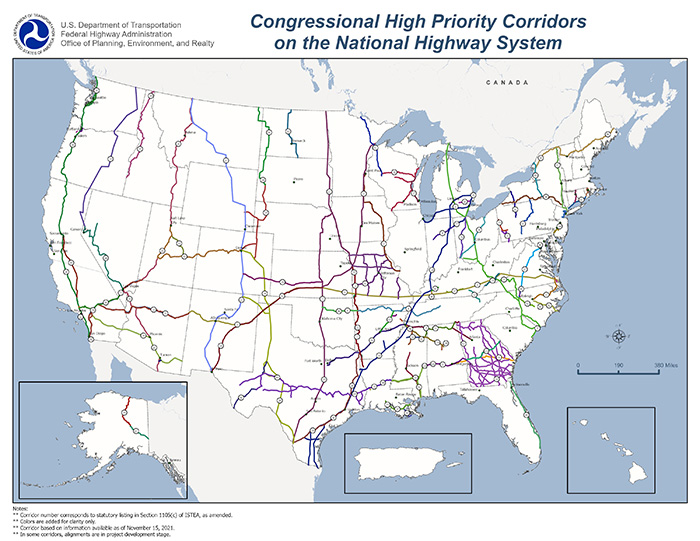Beginning with the Intermodal Surface Transportation Efficiency Act of 1991 (ISTEA), corridors have been designated in Federal transportation legislation as high priority corridors on the National Highway System (NHS) for inclusion in the NHS as specific routes or general corridors. The ISTEA designated 21 corridors. Subsequent legislation added additional corridors and by the end of 2005, there were over 80 such corridors (including corridors that are subsumed or partly subsumed in other high priority corridors.) Some of the corridors are entirely within a single State such as Urban Highway Corridor along M-59 in Michigan or the Birmingham, Alabama Northern Beltline. Other corridors are multi-State such as the East-West Transamerica Corridor from Virginia through Kansas or the I-73/74 North-South Corridor from South Carolina through Michigan. Some corridors are along highways that are already essentially completed and carrying traffic such as Economic Lifeline Corridor along I-15 and I-40 in California, Arizona, and Nevada. Other corridors are generally along the path of anticipated future highways such as the corridor from Sarnia, Ontario, Canada, to the Lower Rio Grande Valley between Texas and Mexico. Finally, some of these corridors are described in detail in legislation, such as the the Dalton Highway from Deadhorse, Alaska to Fairbanks, Alaska. Others are broadly defined such as the Everett-Tacoma FAST [Freight Action Strategy for Everett-Seattle-Tacoma] Corridor in Washington State and some corridors are defined by reference to other legislation such as the Georgia Developmental Highway System Corridors identified in section 32-4-22 of the Official Code of Georgia, Annotated.
These corridors are Congressionally designated. The only criterion for being a Congressionally designated High Priority Corridor is that it is what Congress designates.
As noted below funding was not provided in the current (MAP-21) multiyear surface transportation authorization, however the three previous (ISTEA, TEA-21, and SAFETEA-LU) authorizations either directly or indirectly provided funding for these corridors.
Section 1105(f) of ISTEA authorized funding for fiscal years 1992 through 1997 for some specific high priority corridor segments, and Section 1105(h) authorized some additional funding for high priority corridor feasibility and design studies. NHS, STP and Bridge Program funds authorized by ISTEA may be used to fund improvements to high priority corridors. In certain instances, Interstate Maintenance funds authorized by ISTEA may be used to fund improvements to some high priority corridor routes.
Section 1602 of TEA-21 authorized funding for fiscal years 1998 through 2003 for some specific high priority corridor segments. Also, formula funds for the NHS, STP, Bridge Program, and in certain instances, Interstate Maintenance authorized by TEA-21 were used to fund improvements to high priority corridors. In addition, beginning in FY 1999, the planning and development of high priority corridors was eligible for funding under the discretionary National Corridor Planning and Development Program.
Various sections for SAFETEA-LU provided funds for these high priority corridors. For example, formula funds for the NHS, STP, Bridge Program, the Coordinated Border Infrastructure Program and in certain instances, Interstate Maintenance may be used to fund improvements to high priority corridors. Also, some projects specifically identified under section 1301 (Projects of Regional and National Significance), 1302 (National Corridor Infrastructure Improvement program) and 1701 (High Priority Projects program) will support improvements to these corridors. In Section 1304(d) of SAFETEA-LU, the following phrase appears, "There are authorized to be appropriated to carry out, in accordance with title 23, United States Code, projects on corridors identified in section 1105(c) of the Intermodal Surface Transportation Efficiency Act of 1991 (101 Stat. 2032) such sums as may be necessary." To date, no funds have been appropriated under this authorization
There were no funding allocations to specific projects. The authorization of "such sums as may be necessary" in SAFETEA-LU continues, but funds will be available only if appropriated by Congress.
Section 1105(e) of the ISTEA, as amended, designates all or portions of fourteen high priority corridors as future parts of the Interstate system and authorizes the Secretary to add segments of the corridors to the Interstate System when certain criteria are met.
Statutory listing of Corridor Descriptions
Corridor numbers correspond to Statutory listing in Section 1105(c) of ISTEA, as amended

View a larger version (215 KB, 1056x816) or PDF (1.32 MB) for printing.
View a larger version (552 KB, 1056x816) or Adobe PDF (1.4 Mb) for printing.
Information valid as of October 2012.
Some corridors subject to subsequent adjustment where statutory description is general.